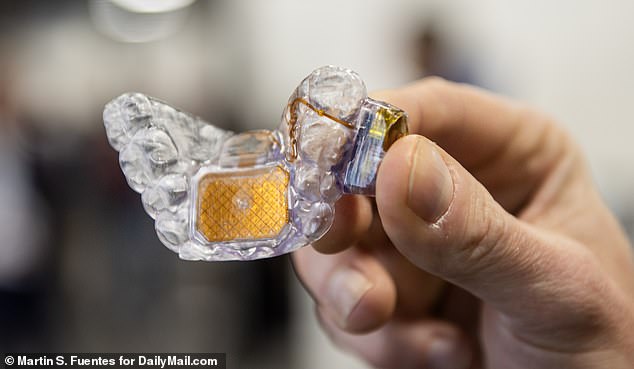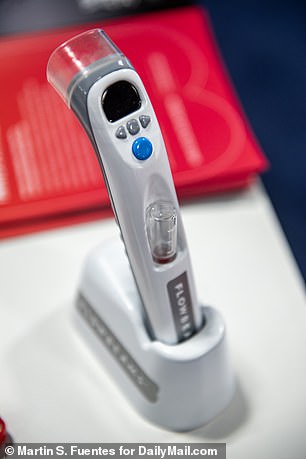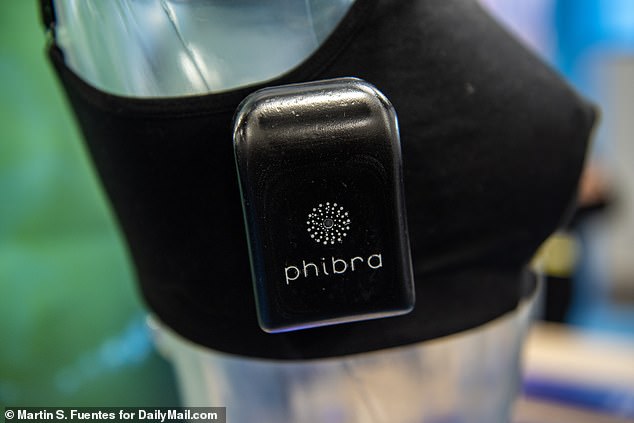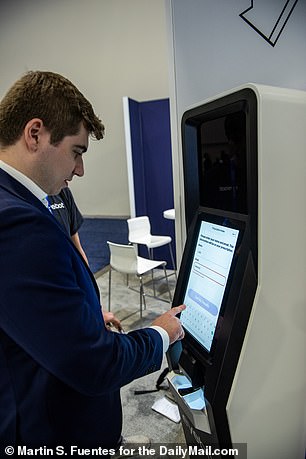The annual CES Las Vegas show is a famous testing ground for some of the slightly wackier health tech ideas.
This year’s is no exception, with developers bringing forward a range of products that could change how many people live their lives.
Many of these products are now in the final stages of development and being released if not already available on early access.
But a number also remain largely conceptual prototypes, such as a mirror for scanning someone for body fat percentage, which its presenter said was still very much just an example of what they could do.
After walking the floors of the show, DailyMail.com can reveal some of the top healthcare devices from this year here:
A computer mouse controlled by your tongue
It sounds like something out of a sci-fi movie, but developers have designed a computer mouse controlled entirely by your tongue.
Named Augmental Mouthpad, the device is shaped like a mini mouthguard with a metal pad in the middle that is inserted into the roof of the mouth.
To create the mouthguard, a 3D scan is taken of the mouth before it is developed to fit neatly inside.

The device has been developed for quadriplegics, or those who struggle to use their upper and lower limbs because of a medical condition.
But it has already had significant interest from gamers, developers said, with some also signing up for the product.
Explaining the device, a spokesperson said someone could move a cursor over the screen by dragging their tongue over the metal area in the center of the device.
To left click, users tap the pad with their tongue, to right click, they suck in air suddenly, and to scroll, they slide the tongue over the pad in one motion.
Asked whether your tongue gets tired using it, a spokesperson said this was highly unlikely — adding that the tongue is used constantly for speaking but does not get tired.
The device was opened up for an early access program in the US this year, and now has 70 users who paid $1,500 for the device.
Developers are planning to launch the product in mid summer, but say it will likely have a higher price tag.
A needleless injection device
It may seem like a pipe dream, but soon it really may be possible to get vaccinated without being jabbed by a needle.
Dutch startup Flowbeams has developed a small pen-like device that can inject the body without tearing the skin.

Rather than using a needle, it super-heats and then fires a jet of fluid ‘thinner than a thread of hair’ at the skin at a speed of 200 miles per hour.
This passes through the skin without tearing cells, the developers say, administering the fluid without causing significant pain or skin damage.
The device is currently being developed for administering Botox, filler and other cosmetic fluids.
But CEO Lea Milovich told DailyMail.com that they were also looking to use the device to inject vaccines or insulin.
Development began in 2014, and FlowBeams was founded three years ago — with the company saying they hope to bring it to market in the next one to two years.
About 25 percent of Americans are afraid of needles, surveys suggest, with about 16 percent saying they routinely avoid injections because of it.
A bra that can diagnose breast cancer
Breast cancer is the most common cancer among women in the US, with an estimated 310,000 cases detected every year — a number set to surge 77 percent by 2050.
Early detection is critical for survival, with women whose cancer is revealed before it spreads having an up to 86 percent chance of survival compared to 31 percent for those where it spreads beyond the breasts


But amid problems with health insurance and the hectic nature of daily life, estimates suggest that roughly 25 percent of women are not getting regular scans.
To plug the gap and warn of the cancer early, French start-up phibra is developing a wearable bra that can monitor the breasts for concerning changes.
Users wear the bra for 15 minutes once a month, which has up to 80 sensors to measure the breasts’ density and temperature.
If it detects any sudden changes, the system would alert the user to book a consultation with a doctor.
Colin Gutton, COO of the company, told DailyMail.com that the aim was to ensure earlier diagnosis of breast cancer and make it accessible to all.
The product is still in the early stages of development, having been tested on 50 women in France to ensure it was safe to use.
The start-up is now seeking funding for large scale trials to further test the product compared to conventional mammograms.
But the developers hope to bring it to market by October 2026, at a price of around $350 to $450 per bra.
They stress it should not be used as a replacement for breast scans, which users should still get as recommended.
Currently, US health officials tell women aged over 40 years old to get scanned for breast cancer every year, and those over 50 to get checked every other year. Amid a rise in breast cancer cases among young women, some of these are also getting scanned.
Mirror, mirror on the wall, who has the lowest body fat percentage of them all?
Another device catching headlines at this year’s CES is a mirror that measures someone’s body fat.

It was unveiled by scales company Withings, who admitted the product was still just a ‘prototype’ and had not yet entered development.
The mirror is a similar shape to an iPhone screen, although much larger, and is attached to a scale-like unit at the base.
Users simply step on the scale that then performs a scan of the body, projecting results on the large mirror.
The technology captures five sets of diagnostics, also including heart health, breathing rate, sleep and vitamin levels in the blood.
In the demonstration for DailyMail.com, the mirror showed details of how the reporter’s alleged body fat and breathing rate had shifted over time.
It also said it had detected low levels of Vitamin C, instantly purchasing supplements for the reporter to take, and a feature with the heart it was concerned about, telling the reporter to contact their doctor.
A Withings spokesperson at CES emphasized that the product was still very much a prototype and that the technology for all this via a mirror was not yet available.
But they said it was meant to be a demonstration of what Withings hopes to achieve in the future.
Free 90-second eye test coming to a store near you
A machine that can test your eyesight and prepare a prescription in just 90 seconds could be coming to a grocery store near you.
The Eyebot is a self-serve machine that does the tests for free, then charges a small fee to issue an ophthalmologist-approved prescription.
It uses the same features as a standard eye test, showing a random sequence of letters that gradually get smaller and a hot air balloon that shifts in and out of focus.

DailyMail.com’s reporter tested the machine while wearing contact lenses, and found it easy to use and effective.
It gave a prescription slightly off perfect, which the founder Dr Martin Hofmann said was likely because of the contacts and suggested the reporter should stick to glasses.
Eyebot has already been rolled out in a handful of ophthalmology stores in Massachusetts, and has been a quick hit — with each machine ‘seeing’ about 100 patients a day.
Founder Matthias Hofmann told DailyMail.com: ‘You say free eye test and, bang, you have a line!’.
The machines are now picking up steam, with a partnership with an unnamed major ophthalmology chain expected to be announced in the early part of this year.
But a spokespeople said they were also looking to get the machines into Walmart, Target or a similar major chain — to make them more accessible to customers.
And the machines were not without fans at CES, with DailyMail.com seeing that — despite returning to the stand three times — that there was always an at least four-person deep queue to try the product.
Hofmann told DailyMail.com that he decided on the invention after finding that eye tests done on smartphones were not popular.
The aim was also to offer a quick and convenient way to get an eye test, that does not involve booking a pricy consultation that can take an hour out of someone’s day.
Of the estimated 93 million Americans at high risk for severe vision loss, only half have visited an eye doctor in the past year — largely due to a lack of awareness or cost.

